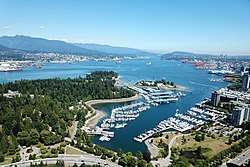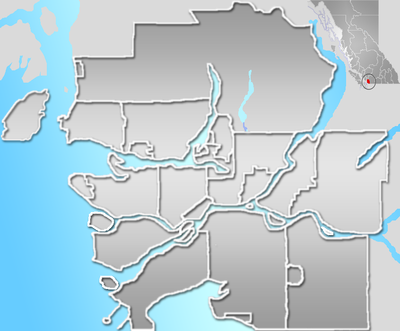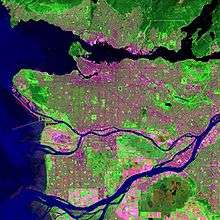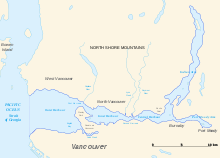Burrard Inlet
Burrard Inlet[1] is a relatively shallow-sided coastal fjord in southwestern British Columbia, Canada. Formed during the last Ice Age, it separates the City of Vancouver and the rest of the low-lying Burrard Peninsula (to the south) from the slopes of the North Shore Mountains, home to the communities of West Vancouver and the City and District of North Vancouver.
| Burrard Inlet | |
|---|---|
 Aerial view of Burrard Inlet | |
 Burrard Inlet Location  Burrard Inlet Burrard Inlet (British Columbia) | |
| Location | Southwestern, British Columbia |
| Coordinates | 49°17′55″N 123°05′07″W |
| Ocean/sea sources | Strait of Georgia |
| Basin countries | Canada |
| Settlements | Vancouver |
History

What is now known as Burrard Inlet has been home to the Indigenous peoples of the Musqueam, Squamish people and Tsleil-waututh, who have resided in this territory for thousands of years. In 1791, the first European explorers in the region, Juan Carrasco and José María Narváez, sailing under orders of Francisco de Eliza, entered the western part of the inlet in their ship, the Santa Saturnina. They failed to find the Fraser River, mistaking the lowland of the river's delta as a major inlet of the sea, which they named Canal de Floridablanca.[2] This led to one of the prime objectives of the 1792 expedition of Dionisio Alcalá Galiano, which was to determine the exact nature of the Canal de Floridablanca. Galiano spent many days exploring the general area, realizing that there was a great river there and sighting Burrard Inlet itself on June 19, 1792. Just days later, the inlet was again named by Captain George Vancouver, after his friend and former shipmate Captain (later Admiral) Sir Harry Burrard.[3][4]:33


In 1888, the inlet was described in The British Columbia Pilot published by the British Admiralty as follows.
Burrard inlet differs from most of the great sounds of this coast in being comparatively easy of access to steam vessels of any size or class, and in the convenient depth of water for anchorage which may be found in almost every part of it; its close proximity to Fraser river, with the great facilities for constructing roads between the two places, and its having become the terminus of the Pacific and Canadian Railway, likewise add considerably to its importance. It is divided into three distinct harbours, viz., English bay or the outer anchorage; Vancouver (formerly called Coal harbour), above the First Narrows; and Port Moody at the head of the eastern arm of the inlet.[5]
Geography
The inlet runs almost directly east from the Strait of Georgia to Port Moody and is urbanized on most of its shores. About two-thirds of the way east from the inlet's mouth, a secondary, much steeper-sided, glacial fjord, Indian Arm, extends straight north from the main inlet, between Belcarra and Deep Cove in North Vancouver, then on into mountainous wilderness. (Indian River, a small dock at the north end of the arm, can be reached by a washed-out logging road from Squamish.)
From Point Atkinson and Point Grey on the west[6] to Port Moody in the east, the inlet is about 25 km (15.5 mi) long; Indian Arm extends about 20 km (12.4 mi) north. Settlements on the shores of Burrard Inlet include Vancouver, West Vancouver, North Vancouver, Burnaby, and Port Moody. Three bridges, the First Narrows Bridge (alias Lions Gate Bridge) (built in the 1930s), the Ironworkers Memorial Second Narrows Crossing (1960) and the CNR railway bridge (1969) at the Second Narrows, and the SeaBus passenger ferry, cross the inlet. Aside from just east of the inlet's mouth (where it includes English Bay), it is widest (about 3 km or 1.9 mi) between the First and Second Narrows, also the busiest part of Vancouver's port.
Port of Vancouver
Protected from the open ocean, the calm waters of Burrard Inlet form Vancouver's primary port area, an excellent one for large ocean-going ships. While some of the shoreline is residential and commercial, much is port-industrial, including railyards, terminals for container and bulk cargo ships, grain elevators, and (towards the eastern end) oil refineries. Freighters waiting to load or discharge cargoes in the inlet often anchor in English Bay, which lies south of the mouth of the inlet and is separated from it by Vancouver's downtown peninsula and Stanley Park.
On the main inlet, a few park areas remain forested as they were centuries ago, but the steep slopes of Indian Arm are so impassable that most have seen no development, despite the proximity of such a major city. Only in 2003 was a rough wilderness hiking trail around the whole of Indian Arm completed, and it was the work of one man over many years.[7]
Major crossings
References
- "Burrard Inlet". Geographical Names Data Base. Natural Resources Canada. Retrieved 2020-06-16.
- Kendrick, John (1990). The Voyage of Sutil and Mexicana, 1792: The last Spanish exploration of the Northwest Coast of America. Spokane, Washington: The Arthur H. Clark Company. p. 19. ISBN 0-87062-203-X.
- Bartroli, Thomas. Genesis of Vancouver City. Vancouver: (Self-published). 1997
- Akrigg, G.P.V.; Akrigg, Helen B. (1986), British Columbia Place Names (3rd, 1997 ed.), Vancouver: UBC Press, ISBN 0-7748-0636-2
- Hydrographic Office of the British Admiralty (1888). The British Columbia Pilot. London, UK: Hydrographic Department of the Admiralty. Page 136.
- "BC Geographical Names". apps.gov.bc.ca. Archived from the original on 2016-03-03.
- Charles Montgomery (Oct 2001). "The Blazer". Western Living Magazine. Archived from the original on 2007-02-27.
External links
| Wikimedia Commons has media related to Burrard Inlet. |
- 2002 Aerial Photos of Vancouver, including several views of Burrard Inlet and its shores